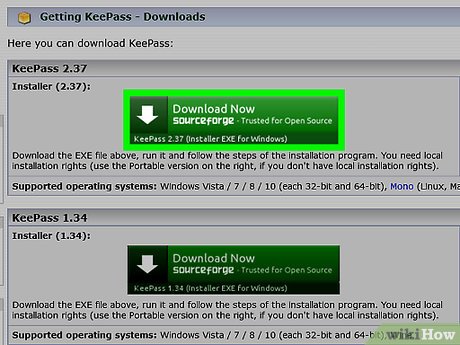How to Manage Your Passwords with KeePass
Method 1 of 3:
Setting up KeePass
-
 Download KeePass by navigating here.
Download KeePass by navigating here. -
 Launch "KeePass".
Launch "KeePass". - Click on the "New" button. You should find the button when KeePass opens up.
- Press the "Save" button.
- Type in your Master Password and click the "OK" button. Pick a master password that you will easily remember.
- Click the "OK" button in the database settings window.
- Click on the Key icon.
- Fill out the information for your first account. Here, the example is a yahoo account.
- Type a title - for example, Yahoo.
- Type your username for that account.
- Type your password for that account.
- Confirm the password by typing it again.
- Click "OK."
- Review the details. This is what your new entry will look like:
- Add any other accounts you want using the same process. For example, you can enter Gmail, MSN, Skype, Hotmail ,or any other type of accounts.
Method 2 of 3:
Using KeePass for Passwords
- Use a saved password. To do this, go to the corresponding website and click the "Sign in" button.
- Bring up KeePass and right-click on your entry that you created. Select "Perform auto type."
Method 3 of 3:
Using MiniKeePass on iOS for Passwords
- Download the app for iOS to use KeePass file on your iOS devices MiniKeePass.Click here to see the app in App Store
- Upload your KeePass.kdbx (database file where the passwords are stored) to a cloud service such as Dropbox. If you are unfamiliar with it, Dropbox article to learn more. Alternative info on uploading files to Dropbox can be found here
- Select the file. Select button numbered one then select button numbered 2 "Open in".
- Choose an option titled "Open in MiniKeePass". Please note depending on the number of apps on your phone, you may have to scroll to the right to find the MiniKeePass option. MiniKeePass will open to display your database(s) of stored passwords. Select it then login as needed.
- Navigate as needed to the location of your credentials. You could also just type out the name, either way that you prefer, once you've found the entry, select & open it.
- Tap the username and password fields until the option appears to copy. Friendly notice I find that there is approximately 30 seconds before the info is cleared out from the clipboard so don't delay in pasting in the info!
- Switch over to the app needing the credential via double tapping the Apple Home button twice to switch screens to select the app requesting login credentials.
- Press then hold until you can paste in the credential. Repeat this process until you can login.
Update 04 March 2020
You should read it
- Experience Keepass, impressive password manager
- Instructions for password management with KeePass
- How to Prevent Notifications when Screen Mirroring on a Mac
- How to fix the problem of left clicking on Windows
- How to Install the Windows 7 OS on a Portable Hard Drive
- 20 small tricks with Edge browser you should know (Part 2)
- Create Button in CSS
- How to Add Email Accounts to a Mac
- How to Right Click on a Mac
- How to Adjust the Master Volume in Windows 7
- KEEPASS 0.93B (KP): 'Safe' is safe for all passwords
- Data type in C #
